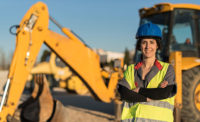OSHA has announced a new rule addressing the use of cranes and derricks in construction, which will replace a decades-old standard. Approximately 267,000 construction, crane rental and crane certification establishments employing about 4.8 million workers will be affected by the rule.
The previous rule, which dated back to 1971, was based on 40-year-old standards. Stakeholders from the construction industry recognized the need to update the safety requirements, methods and practices for cranes and derricks, and to incorporate technological advances in order to provide improved protection for those who work on and around cranes and derricks.
The new rule is designed to prevent the leading causes of fatalities, including electrocution, crushed-by/struck-by hazards during assembly/disassembly, collapse and overturn. It also sets requirements for ground conditions and crane operator assessment. In addition, the rule addresses tower crane hazards, addresses the use of synthetic slings for assembly/disassembly work, and clarifies the scope of the regulation by providing both a functional description and a list of examples for the equipment that is covered.
In 2003, the secretary of labor appointed 23 experienced Cranes and Derricks Advisory Committee members representing manufacturers and trade associations, who met 11 times until a consensus on the regulatory text was reached in July 2004. The proposed rule was published Oct. 9, 2008, and the public was invited to submit comments until Jan. 22, 2009. Public hearings were held in March 2009, and the public comment period on those proceedings closed in June 2009. OSHA staff incorporated input from the public comments and testimony to develop the final regulatory text.
The new rule will take effect on Nov. 8, 2010.
OSHA publishes final rule on cranes and derricks in construction (7/29)
Looking for a reprint of this article?
From high-res PDFs to custom plaques, order your copy today!





